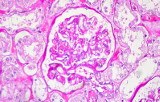
Special stains for carbohydrates
Carbohydrates are involved in a wide range of cellular functions including protein folding, cell adhesion, enzymatic activity, and immune recognition.
Carbohydrate detection techniques provide valuable diagnostic results that help characterize various pathological conditions such as neoplasia, inflammation, autoimmune diseases and infectious diseases.
Over the years, a variety of terminology has been used to describe and classify tissue carbohydrates. The two main entities are: glycogen and mucins (also called mucosubstances).
Glycogen is a simple polysaccharide that is widely distributed throughout the body. It is found in greater amounts in the liver, hair follicles, endometrial glands, vaginal and ectocervical epithelium, and cardiac and skeletal muscles.
Glycogen may have diagnostic significance in several types of tumors, including carcinoma, mesothelioma and rhabdomyosarcoma.
Mucins are a large family of polypeptides that are secreted by a variety of epithelial and connective tissue cells. They can function as lubricants or help with cell adhesion or host defense.
The classification of mucins is complex but can be simply divided into neutral and acidic mucins. There are many subtypes of acidic mucins depending on their origin (epithelial tissue versus connective tissue) and their molecular structure (sulfated, carboxylated). Mucins are produced by many tumors, including carcinoma, liposarcoma and mesothelioma.




